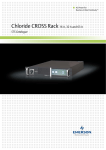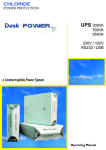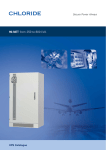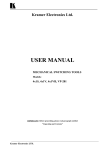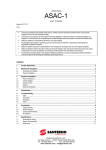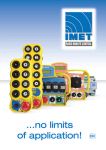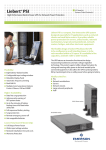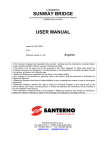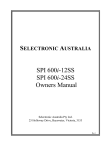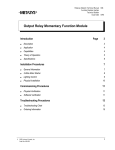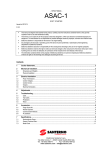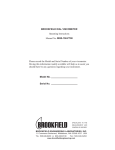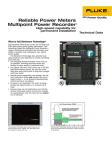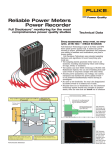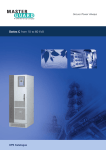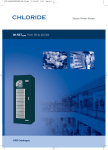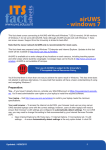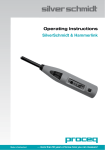Download CROSS Rack HV
Transcript
Secure Power Always CROSS Rack HV 16 A, 32 A and 63 A STS Catalogue Important note! The technical data enclosed is for general information. Please note that the operating instructions and references indicated on the products are for installation, operation and maintenance. Product designations All product designations used are trademarks or product names of Chloride Group PLC or its subsidiary companies. This publication is issued to provide outline information and is not deemed to form any part of any offer or contract. The company has a policy of continuous product development and improvement and we therefore reserve the right to vary any information quoted without prior notice. Person to contact System Transfer Switches CROSS Rack HV (2 Poles) Dual-Pole Complete Reliability On-line Static Switch 16 A, 32 A and 63 A STS Catalogue • 2007 01 Scope 2 System Control 2 Protection Devices and Control Functions 3 Monitoring, Control and Communication 4 Technical Data 5 Installation Requirements 6 MKA4ST0UKCROSSR/CROSS Rack/Rev. 4-12/2007/UK CHLORIDE CROSS Rack HV STS 16 A, 32 A and 63 A 1. Scope This specification describes the CROSS Rack series of single-phase two-pole static switches with manual maintenance Bypass switch, and presents their electrical and mechanical features. CROSS Rack is optimised for the installation in 19” standard rack cabinets; the vertical rack space occupation is 2 HU for all the models and the protection degree is IP21 (i.e. no openings are present on the top or bottom of the CROSS Rack enclosure). The air cooling is front-to-back, and is obtained using fully redundant and monitored fans. All these features make CROSS Rack the ideal solution for rack-level power protection in modern Data Centres. 1.1 The system CROSS Rack operates in Fixed Priority Mode: the user selects the preferred input line and CROSS Rack will transfer to the priority line whenever its parameters fall within acceptable values. transfer will occur as described in 2.2.1. The acceptable phase angle difference between the two lines for asynchronous transfers will be within a 15° range and selectable by the user. CROSS Rack will function so that the transfer between the two sources will be break-before-make on both poles, thus ensuring that the two sources will never be directly connected. In order to maximise reliability, CROSS Rack’s control logic will be redundant and minimise the use of common components. CROSS Rack will rely on front to back, forced and fully redundant cooling. CROSS Rack will ensure switching between independent AC power sources in both synchronous and asynchronous conditions. When the two lines are synchronous, CROSS Rack will transfer between the sources within typically 6 ms following a line failure. In asynchronous conditions CROSS Rack shall ensure redundant power to critical loads by providing the ability to switch between two alternative single-phase power sources. Switching will occur whenever the line supplying the load no longer falls within the acceptable tolerance values. MODEL 1.2 Models available CROSS Rack shall include models with single-phase input and single-phase output as specified in the following table referring to a nominal voltage of 230V: Current (A) Input Output CROSS Rack HV 16 16 Single-phase Single-phase CROSS Rack HV 32 32 Single-phase Single-phase CROSS Rack HV 63 63 Single-phase Single-phase Nominal currents are intended as continuous and may apply to any kind of linear and non linear load (maximum crest factor 3:1). 2. System Control The advanced and rugged control logic of CROSS Rack shall provide the highest safety for the load through a Break-Before-Make switching in any mode of operation. All the power supplies and SCR firing circuits are totally redundant. The coloured LED on the front panel of CROSS Rack shall provide a simple and immediate indication of the operational state of the system. For a more detailed and complete description on local diagnostics, see section 4.2. In the event of both sources falling outside the acceptable tolerance windows, CROSS Rack can be programmed to have different behaviours (stay on source1, stay on source2, open both static switches). possible to choose between transferring in the shortest period possible (6ms), as if the sources were synchronised, or introducing an additional delay (selectable between 0 and 20ms) to the normal transfer time (default condition). 2.2 Transfer modes 2.2.2 Transfer due to re-transfer of load to priority source CROSS Rack will perform a BreakBefore-Make switching under any condition. Operating modes are described as follows: 2.1 Mode of operation 2.2.1 Line failure transfer CROSS Rack will attribute a priority to one of the two sources. The priority source will be selected from the front panel by pressing pushbutton P. The selected source will be indicated by the corresponding LED (S1 or S2). The selected priority source will continuously supply the load provided it stays within the tolerance windows. Failure of the priority source will cause transfer of the load to the reserve (low priority) source. When the priority line returns within the acceptable tolerance window the load will automatically be transferred back to the priority line following a delay time - re-transfer time. MKA4ST0UKCROSSR/CROSS Rack/Rev. 4-12/2007/UK Switching occurs if the characteristic parameters of the active power source (preferred or alternative) supplying the load go outside defined limits. The parameters tested are the root mean square (RMS) and instantaneous values of the voltage, which must remain within a defined acceptance window. Once the parameters of the power source have returned to normal, if the load is supplied by the source selected as the alternative, it is automatically transferred back to the priority source (see also 2.2.2). Where switching occurs while sources are unsynchronised, it is 02 In conditions where the priority source is not the one supplying the load (switching due to source fault condition or change of priority via button P) CROSS Rack will automatically transfer the load to the priority source as soon as possible. Specifically, automatic switching to the priority source will occur only when the parameters of this last are within acceptable limits and when synchronisation is established. If the priority source is out of limits, transfer will be effected only after it has remained stable and within limits for a preset period (5 seconds). In the case of loss of synchronisation, transfer will only take place when the phase difference between the two sources is less than a preset value (10° by default). CHLORIDE CROSS Rack HV STS 16 A, 32 A and 63 A 2. System Control In any event, such switching occurs only when both sources are within tolerance and synchronised (transfer is also effected during the zero current crossing control in optimum conditions). All settings and operating modes of CROSS Rack can be easily modified or enabled by trained service engineers. 2.3 Operation under output short circuit CROSS Rack will inhibit transfer whenever an output short circuit is detected, thus avoiding the transfer of the short circuit to the alternative source. The instantaneous short circuit threshold level is 3In. Only when the current falls below the threshold value and the voltage value is acceptable, does CROSS Rack automatically reset and enable transfer. CROSS Rack’s internal logic will inhibit transfers even if an upstream protection device trips and the current goes to zero. 2.4 Operation under overload CROSS Rack will be able to sustain the following overload conditions: 125% 150% 700% 10 min. 1 min. 0,6 sec. 2.5 Maintenance by-pass and HotSwap module CROSS Rack is equipped with bypass switches, which allows complete maintenance without causing a power interruption to the critical output load. Both the input sources can be used during the maintenance bypass operations. The switching devices ensure that the direct connection of the two sources is never possible, even upon a wrong user operation. The control logic will ensure that, in the event of an accidental closure of the by-pass on the passive line, CROSS Rack will transfer the load so as to avoid a permanent paralleling of the two sources, regardless of the operating modes described above. Furthermore, to ensure maintenance time is kept at a minimum (very low MTTR, less than 1 minute), the entire static module (logic and solid state power devices) can be extracted without interrupting the supply (Hot-Swap maintenance) after having switched the unit to manual bypass as described above. Refer to the User Manual for the detailed description of the Hot-Swap module maintenance. 3. Protection Devices and Control Functions Devices to protect the cables and loads have to be installed upstream and downstream from the equipment. These devices can be automatic switches, or fuses and switches, selected in conformity with the CROSS Rack current rating, the overload performance, the internal fuses described in 3.1 and the downstream protections and loads. 3.1 Internal fuses CROSS Rack will be provided with fuses on the input phase of each source (660 Vac, 100 A; pre-arching I2T=2050 amp2s, total I2T @ 230 V = 3740 Amp2s). These fuses have the sole function of protecting the subsystem and devices inside the unit itself from permanent output short circuit. Downstream protection devices will therefore have to be correctly dimensioned and coordinated. 3.2 Backfeed protection control 3.3 SCR open detector This feature prevents even the most remote possibility of electric shock hazards on the alternative CROSS Rack mains supply terminal (the source that is not currently supplying the load) in the event of a static switch SCR failure (SCR shorted). The user interface includes two normally-closed voltage free contacts. These are used to activate an external isolating device (electromechanical relays or minimum voltage tripping relays can be used) when backfeed is detected. The two external isolating devices are not included with CROSS Rack (in conformity with Standards), and must be 2-pole, air-gap isolator devices as defined by IEC/EN 62310-1 (4.2.1.4). CROSS Rack will also be able to diagnose the fault condition Open Circuit SCR on the active line. This fault condition will cause a transfer to the passive line and inhibit further transfers. 03 3.4 Redundant cooling CROSS Rack is equipped with two fully redundant cooling fans. This feature allows a very reliable front-to-back ventilation. Each fan is provided with a sensor which is able to detect the failure, which is immediately communicated to the user. MKA4ST0UKCROSSR/CROSS Rack/Rev. 4-12/2007/UK CHLORIDE CROSS Rack HV STS 16 A, 32 A and 63 A 4. Monitoring, Control and Communication 4.1 General CROSS Rack shall incorporate the necessary controls, instruments and indicators to allow the operator to monitor the system status and performance, as well as to take appropriate actions. • LED 11 & 12 - Static Switch Status Indicator LED ON = Static Switch CLOSED LED OFF = Static Switch OPEN • LED 13 - Output Alarm LED13 ON = Switching Inhibited due to Output short circuit and/or SCR open fault 4.2 Control signals 4.4 Control panel CROSS Rack is fitted with a control panel on the front part of the unit. This includes a mimic panel and warning lights (LED) to indicate the operating status of the unit in real time. The status of the sources, the static switches, the By-pass, the load condition and the maximum operating temperature are all monitored continuously. The functions of the LED are described in par. 4.3. On the control panel a pushbutton is also present which allows the user to set the priority between the sources and a LED which indicates the current priority. 4.3 Mimic LED display The controls are located on the front panel (see Fig.1). S1 S2 Priority selection button Press to select system priority Source S1 or S2 Refer to para 2.1 for more information about the behaviour of CROSS Rack during Priority Selection Reset button Press to reset permanent block (see SCR Open Fault Alarm) Note: The Reset command is accepted only if both sources are within the tolerances and they are synchronised. 4.5 Output user signals: • LED 1 & 2 - Priority Source Indicator LED 1 ON and LED 2 OFF = Priority on S1 LED 1 OFF and LED 2 ON = Priority on S2 • LED 4 Summary Alarm This LED is illuminated under the following alarm conditions: - If at least one source is out of tolerance - If there is a loss of synchronisation between the sources - If the Bypass switch is closed - If the system is in Over-temperature - If there is an Output short circuit - If there is a general SCR fault - If there is a blocked fan - If the EPO is active - If the Backfeed Detector is active • A summary alarm contact is available as a cable screw terminal connector, interfaced with a voltage free relay contact (NO/NC 1A 220Vac). The summary alarm is activated under the conditions described in 4.3. for LED 4. Digital Outputs list: • Summary Alarm • Priority on S1 / S2 • Output Short Circuit • SCR-Open Fault • System Over-temperature • Bypass S1 Closed • Bypass S2 Closed • EPO Active • S1 Out Of Tolerance • S2 Out Of Tolerance • Sources Synchronised • S1 Static Switch Open/Closed • S2 Static Switch Open/Closed • Backfeed detector active S1 • Backfeed detector active S2 • Fan failure Digital outputs are optoisolated signals (phototransistors); the power supply has to be provided externally (maximum current 3mA, maximum DC voltage +15V). 4.6 Input user signals: Emergency power Off (EPO). When the EPO is activated, all the static switches are opened. • CROSS Rack is also equipped with a full set of digital optically isolated output contacts. These contacts can be accessed from the rear panel of the unit on a 25-pin socket. • LED 6 & 7 - By-pass Switch Status Indicators LED ON = By-pass Switch CLOSED LED OFF = By-pass Switch OPEN S1 S2 • LED 8 & 9 - Source S1 and S2 Status Indicators LED ON = Source OK LED OFF = Source OUT OF TOLERANCE • LED 10 - Loss of Synchronisation Indicator LED ON = Sources NOT SYNCHRONISED LED OFF = Sources SYNCHRONISED MKA4ST0UKCROSSR/CROSS Rack/Rev. 4-12/2007/UK Figure 1. A view of the display and control panel. 04 CHLORIDE CROSS Rack HV STS 16 A, 32 A and 63 A 5. Technical Data STS Unit Nominal Voltage (selectable) Input voltage acceptance window (tolerance ±2) Rating 16 (V) 230 (220/240) (%) ±12 Input phases Nominal Current 2 (Ph + N) (Hz) (A) 50 16 32 Input power ports 2 Output power ports 1 Efficiency at Nominal Power (%) >98 Overload capacity For 10 minutes For 1 minute For 0,6 seconds (%) (%) (%) 125 150 700 (A2s) (A) 15000 1750 (A2s) (A2s) 660 Vac, 100A fast 2050 3740 (°C) 0 - 40 SCR Characteristics I2T @ Tvj = 125°C ITSM @ Tvj = 125°C Fuses Pre-arching I2T Total I2T @ 230V Temperature range 63 Single phase (Ph + N) Number of switching poles Nominal frequency 32 Synchronization range 63 10° ( 7.5° - 15° selectable ) Cooling Front to back, Forced, Fully redundant Transfer Mode Break-Before- Making Switching (No source overlap) Transfer Time worst case zero voltage source failure typical zero voltage source failure (msec) (msec) CBEMA – ITIC compliant ≤6 ≤4 Additional transfer delay time for non-synchronous transitions (msec) 10 ± 2 ( 0 – 20 selectable) Re-transfer time (s) Instant Overcurrent Threshold 5 3 In Dimensions: Width Height Depth (w/o handles) Weight (1) 19’’ 2U 700mm (kg) Safety 23 CE marking, IEC/EN 62310-1 EMC Compatibility IEC/EN 62040-2, Class C2 Protection degree IP21 Acoustic Noise (dBA) <45 MTBF >800 kh MTTR <1 min (1) for CBEMA-ITIC curve please consult www.itic.org 05 MKA4ST0UKCROSSR/CROSS Rack/Rev. 4-12/2007/UK CHLORIDE CROSS Rack HV STS 16 A, 32 A and 63 A 6. Installation Requirements For detailed installation requirements please refer to the User Manual. No additional space is required below and above CROSS Rack, and no openings are present on the top or bottom of the CROSS Rack enclosure. SUMMARY OF CROSS RACK’S KEY FEATURES AND BENEFITS Break Before Make (BBM) Technology A crucial function of the CROSS STS is its ‘break-before-make’ switching operation. This type of transfer takes place in order to prevent the passage of current between the sources. This ensures that the two live feeds are never connected in parallel. The CROSS static switch also ensures that switching between the two power supplies occurs under both synchronous and asynchronous conditions relative to the input waveforms, within CBEMA guidelines. This is the feature which makes the CROSS radically different to other static switches, since the CROSS guarantees BBM in any conditions, with any type of load. Emergency switching Emergency switching is possible whether or not the sources are synchronised. In both cases, the emergency transfer to the alternative source always occurs within just a few msec. During switching with the sources out of synchronism a delay can also be added to the transfer time. This delay may prove indispensable if the load downstream is incompatible with the sudden switching between two out of phase sources. Short-Circuit Protection Recognition of a short-circuit downstream of the CROSS, caused by loads or distribution, is also managed in that switching to the alternative source is inhibited during such an event. This has a dual purpose: to guarantee activation of the protection devices downstream and, above all, to prevent any load fault being transferred to the alternative source. MKA4ST0UKCROSSR/CROSS Rack/Rev. 4-12/2007/UK 06 CHLORIDE CROSS Rack HV STS 16 A, 32 A and 63 A Notes 07 MKA4ST0UKCROSSR/CROSS Rack/Rev. 4-12/2007/UK CHLORIDE CROSS Rack HV STS 16 A, 32 A and 63 A Notes MKA4ST0UKCROSSR/CROSS Rack/Rev. 4-12/2007/UK 08 Chloride UPS Systems WORLD HEADQUARTERS Via Fornace 30 40023 Castel Guelfo (BO) Italy T +39 0542 632 111 F +39 0542 632 120 E [email protected] Closest Chloride Contact in Australia: Chloride Power Protection Ground Floor 16 Giffnock St, North Ryde NSW 2113 Australia Closest Chloride Contact in UAE: Chloride UPS Systems Middle East Building 5, Office 104 Dubai Internet City - Dubai UAE PO Box 72536 Closest Chloride Contact in South East Asia: CHLD Singapore Pte Ltd 2 Corporation Road #03-07 Corporation Place Singapore 618494 T +61 2 9888 1266 F +61 2 9888 1966 E [email protected] T +971 4 391 3205 F +971 4 391 6803 E [email protected] T +65 (0) 6481 4776 F +65 (0) 6481 0552 E [email protected] www.chloridepower.com/au www.chloridepower.com/middle-east www.chloridepower.com.sg Closest Chloride Contact in UK: Chloride Power Protection George Curl Way Southampton, Hampshire SO18 2RY United Kingdom Closest Chloride Contact in USA: Chloride Power Protection 27944 North Bradley Road Libertyville IL 60048 USA T +44 (0) 23 8061 0311 F +44 (0) 23 8061 0852 E [email protected] T +1 800 239 2257 F +1 800 833 6829 E [email protected] www.chloridepower.co.uk www.chloridepower.com/us For a full list of contacts please visit our website at www.chloridepower.com Certificate No. EMS 76732 Certificate No. FM 11043 MKA4ST0UKCROSSR www.chloridepower.com












